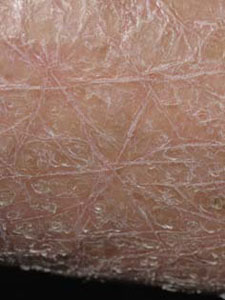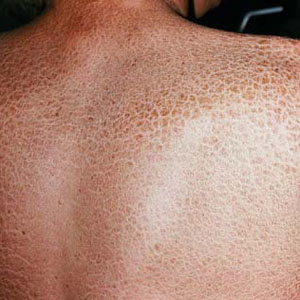MANAGING ICHTHYOSIS
What is ichthyosis?
Ichthyosis is characterised by persistently dry, thickened, rough, fish scale skin. There are at least 20 varieties of ichthyosis, including inherited and acquired forms.
Ichthyosis vulgaris, accounts for 95% of all ichthyosis cases. Inheritance is autosomal dominant i.e. it is passed from a parent to about half their children. Signs and symptoms of ichthyosis vulgaris usually become apparent within the first year of life.
Acquired ichthyosis is not inherited and occurs for the first time in adulthood. It is usually associated with some general disease, such as underactive thyroid states, sarcoidosis, lymphoma, generalised cancer or HIV infection. It may be provoked by certain medications (such as kava, nicotinic acid and hydroxyurea).
What causes ichthyosis?
Inherited forms of ichthyosis occur as a result of a genetic mutation. The mutated gene causes an abnormality in the normal lifecycle of skin. Whilst in most people, the growth, dying and shedding of skin happens unnoticed, people with ichthyosis reproduce new skin cells at a rate faster than they can shed it, or reproduce at a normal rate but the rate of shedding is too slow.
Either way there is a build up of dry scaly skin.
What are the signs and symptoms of ichthyosis?
Although the signs and symptoms may vary amongst the different types of ichthyosis, they all show the characteristic dry, rough, scaly skin. Key characteristics of the four main types of inherited ichthyosis are listed in the table below.
Type of ichthyosis | Features |
Ichthyosis vulgari | Face and scalp. The bends of arms and legs usually spared. Palms are excessively lined Associated with atopic dermatitis |
Lamellar ichthyosi | Scaling occurs over the whole body, including creases and bends May result in drooping lower eyelids |
Epidermolytic hyperkeratosis | Skin is moist, red, and tender at birth Fluid filled blisters may occur which may become infected and give rise to a foul skin odour Thick, generalized scaling occurs within a few days Pathology shows epidermolytic hyperkeratosis |
X-linked ichthyosi | May be associated with testicular disease |


How common is ichthyosis and who gets it?
Apart from ichthyosis vulgaris all other forms of ichthyosis are rare. Ichthyosis vulgaris affects about 1:250 individuals. Ichthyosis occurs worldwide and affects people of all races.
What problems does ichthyosis cause?
People with ichthyosis have a normal lifespan. However they may need to spend several hours each day caring for their skin so they can lead as much of a normal life as possible. At some point during their life people with severe ichthyosis may come up against some of the following problems:
Overheating: ichthyosis may affect normal temperature control by reducing the ability to sweat
Limited movement: dry, scaly skin may make it too painful to move some parts of the body
Secondary infection: cracking and splitting of the skin may lead to skin infections and sometimes systemic infections
Impaired hearing or eyesight: skin may build up over the ears or eyes
What treatment is available?
There is no cure for ichthyosis. The main goal of treatment is to moisturise and exfoliate. This helps prevent dryness, scaling, cracking and build-up of skin.
People with ichthyosis need to bathe, moisturise and exfoliate their skin on a daily regular basis. Your dermatologist may prescribe or recommend moisturising creams and ointments to keep the condition under control. In severe cases they may prescribe oral retinoids such as acitretin or isotretinoin. This can help to reduce scaling. Oral antibiotics may be prescribed if secondary infection occurs.
The following skin care tips may help:
- Apply lotions and creams to wet skin to trap in the moisture (within 3 minutes of showering/bathing)
- Rub gently a pumice stone on wet skin to help remove thickened crusty skin
- Brush washed hair to remove scales from scalp
- Lanolin creams and products containing urea, lactic acid and other alpha hydroxy acids may help to exfoliate and moisturise skin.